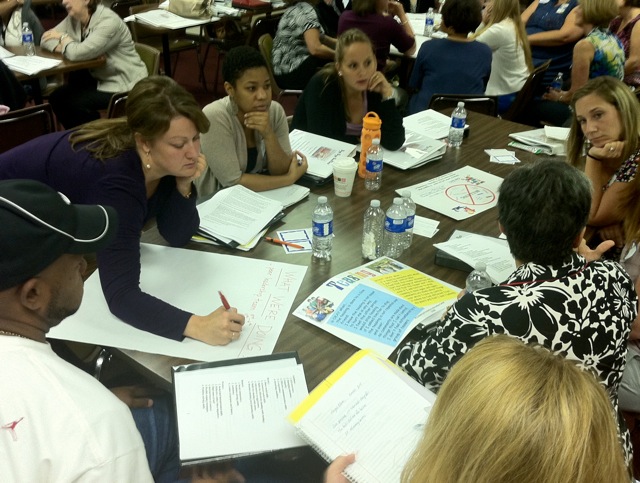
Teachers, counselors and administrators brainstorm during anti-bullying workshop at the Cobb County School District. Photo credit: Ken Edelstein
On March 10, President Obama turned up the spotlight on school bullying. For a couple of years, a handful of high-profile tragedies — often having to do with the rising problem of students picking on other students via social media — had brought unprecedented attention to the issue.
Now, the White House was holding its first ever “Conference on Bullying Prevention.” And the president and the First Lady welcomed an audience of parents, educators, advocates and government officials by expressing how seriously they took the issue -- both as leaders and as parents.
“We’ve got to make sure our young people know that if they’re in trouble, there are caring adults who can help and young adults that can help,that even if they’re having a tough time, they’re going to get through it, and there’s a whole world full of possibility waiting for them,” Obama said. “We also have to make sure we’re doing everything we can so that no child is in that position in the first place.”
Here’s the irony: At the same time that educators, parents and politicians decry bullying and other school violence, the Obama administration has presided over the elimination of all funding for the chief federal program designed to prevent school violence — a program that had been the backbone for anti-school-violence efforts across the country.
From 1987 through 2009, Congress sent hundreds of millions of dollars a year in Safe and Drug Free Schools and Communities grants to the states. That money funded violence prevention programs in almost every school district in the country.
But those programs have been running on fumes for the last two years. Faced with federal budget problems, Congress opted in 2009 to eliminate Safe and Drug Free Schools grants entirely. Because districts were allowed to spend Safe and Drug Free School grants they received in 2009 over the course of 27 months, the funding shortfall is slowing rippling to the local level.
In Utah, despite a healthy dose of state money that supports its violence prevention programs, one of the largest school districts was forced this year to lay off 12 people who were showing teachers and kids how to avoid violence at the school level. And in Cobb County, Georgia, the administrator of an anti-bullying program that’s held out as a state-wide model expects he’ll be dismantling that program by next fall.
“Right now, there won’t be money for this in September,” says Jeff Inman, Cobb’s coordinator for violence and prevention programs.
Together with two highly-qualified staff specialists -- whom he refers to as his “bully professionals” -- Inman runs a multilevel anti-bullying program. In addition to dealing with the problem at the high-school level, the program is designed to teach elementary and middle-school students what bullying is, how to help stop it, and how to avoid it. The theory is that it’s a lot less costly — both for the kids and from a budget standpoint — to prevent bullying from ever occurring than to have to deal with the outfall from it later.

President Barack Obama and First Lady Michelle Obama talk with parents Sirdeaner Walker and Kirk Smalley in the Blue Room of the White House before the start of the Conference on Bullying Prevention, March 10, 2011. (Official White House Photo by Pete Souza)
But, if the federal money isn’t reinstated, Inman doesn’t know how the district will be able to pay his “bully professionals,” or for that matter how the district can continue to help schools teach their students how to avoid bullying,
In 2010, Kevin Jennings, a U.S. Department of Education official, did manage to put two much smaller funding sources in place as a partial replacement for Safe and Drug Free Schools. But the first of those, Safe and Supportive Schools grants, are being provided to only 11 states that had to compete for the money; in most cases even those states are receiving less than what they’d been getting through Safe and Drug Free Schools.
Jennings also worked to obtain “bridge grants” — ostensibly to help programs make the transition to other funding sources. In most cases, however, those funding sources haven’t been available, leading advocates to refer to the bridge grants as “bridge-to-nowhere grants.”
The cutbacks stunned the counselors and school administrators closest to the programs — not just because they believe the programs have been well-worth the investment, but also because they thought, that after years of declining budgets, Obama administration officials were sure to be allies.
“We were really surprised,” one state official said. “We thought we would get more support. We were fighting off Republican plans to make all these cutbacks for years. But then Obama came in, and just like that it’s all gone."
Those involved in violence prevention at the local level say the Safe and Drug Free Schools cuts are dismantling an entire infrastructure of professionals, programs and relationships that has served as the backbone for efforts to combat bullying, drugs and other social problems in the schools.
“Some of those people are just disappearing,” says Verne Larsen, a Utah education official who chairs the National Network of Safe & Drug Free Schools and Communities. “You take the people away and the program really fails. ... It kinds of rips at our heart strings when we see something like this happening.”
Larsen expresses some hope that Congress and the Obama Administration will find the money to support violence prevention programs. He notes that Sen. Tom Harkin, D-Iowa, earlier this month unveiled his Successful, Safe and Healthy Students Act, which would bundle a wide variety of “conditions-for-learning” programs into one umbrella grant program.
For the last few years, conditions for learning were grouped under Title IV of President Bush’s No Child Left Behind Act, but they were funded as a variety of programs, ranging from Safe and Drug Free Schools to smaller nutrition and physical education programs. Harken is hoping to incorporate his bill into an updated education authorization bill that Congress is working on this year.
“I think they’re beginning to realize at the federal level that they just did away with the structure that was running these programs,” Larsen says.
Even if that’s the case, however, funding the programs will be an uphill battle. On May 13, House Republicans unveiled a list of 43 more Title IV programs that they would like to see eliminated; the House seems to be in no mood to revive a program that’s already been killed off.
Then, on May 19, anti-violence advocates received another blow: Jennings, the deputy assistant secretary of education who was perceived as the advocates’ chief ally in the administration announced that plans to leave his post to run a nonprofit organization.

I think they’re beginning to realize at the federal level that they just did away with the structure that was running these programs.
Great post, do you mind if I re-blog this (with full attribution and linking)? I really want to share it with my readers, they would find it very useful.
Important programs that help to define tomorrow’s future leaders are being cut. We are doing a lame job of protecting our kids. We talk about it! There’s an epidemic and we – adults who should know – are turning a blind eye and a deaf ear to its widespread ramifications.